Eni Bundle
Who Really Calls the Shots at Eni?
Unraveling the Eni SWOT Analysis is just the beginning; the true power lies in understanding its ownership. The question of "Who owns Eni" is paramount for investors, analysts, and anyone interested in the future of the Italian energy giant. This exploration delves into the intricate network of Eni shareholders and the forces that shape its strategic direction.
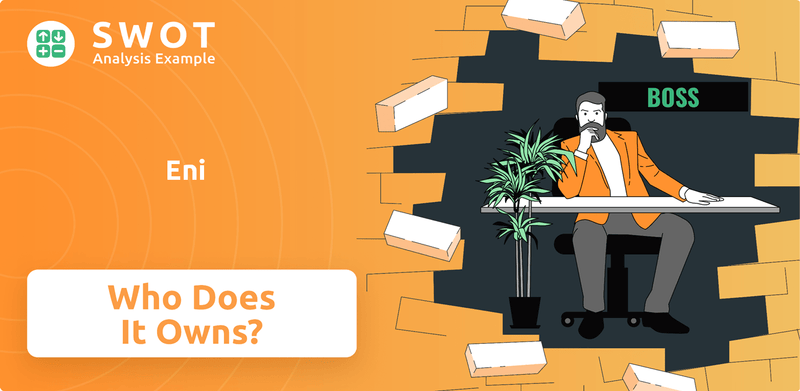
From its roots as an Italian energy company to its current global presence, understanding Eni's ownership structure is key to grasping its operational strategies. Examining the Eni SWOT Analysis helps to understand the impact of the government stake in Eni and the influence of major investors on this publicly traded company. This analysis will provide valuable insights into who controls Eni's decisions and how its ownership impacts its financial performance.
Who Founded Eni?
The Italian energy company, Eni S.p.A., originated in 1953 as a state-controlled entity named Ente Nazionale Idrocarburi (Eni). This structure meant that it didn't have traditional founders in the way a private company would. Instead, its ownership was entirely vested in the Italian government from its inception, reflecting a post-World War II strategy to manage the nation's energy resources.
The driving force behind Eni's creation was Enrico Mattei, who had been the head of AGIP, a pre-existing state-owned oil company. Mattei played a crucial role in the transformation of AGIP and the subsequent formation of Eni, serving as its first president until his death in 1962. His vision centered on an independent Italian energy policy.
At its inception, the Eni ownership structure was straightforward: the Italian state held 100% of the company. This setup meant there were no private investors or early shareholders in the initial phase. The company's mission was to serve as a strategic national asset, with control entirely centralized within the Italian government. This arrangement shaped its operational scope and financial structure, with Mattei wielding significant influence over its direction.
Eni was established by the Italian government, not private individuals. Its creation was a strategic move to manage Italy's energy resources.
Enrico Mattei, the head of AGIP, was instrumental in the formation of Eni. He served as its first president and championed an independent Italian energy policy.
The Italian state initially owned 100% of Eni. There were no private shareholders or external investors during this period.
Control was entirely within the Italian government. Mattei had significant influence over the company's direction and expansion.
Eni was designed to be a strategic national asset. It was created to serve the interests of the Italian state.
Early agreements were based on government mandates. They defined Eni's operational scope and financial structure.
Understanding the early history of Eni company owner is crucial for grasping its evolution. The company's origins as a state-owned enterprise shaped its initial strategies and objectives. The Italian government's role in Eni has influenced its operations and its relationship with the energy sector. For more details, you can read a brief history of Eni. Today, the Eni shareholders include both the Italian government and public investors, reflecting a shift from complete state control to a mixed ownership model. The Italian government still holds a significant stake, influencing the company's strategic direction. The company's Eni stock is traded on the stock market, and its market capitalization fluctuates based on various factors, including financial performance and market conditions. As of early 2024, Eni's market capitalization was around €45 billion, reflecting its position as a major player in the global energy market. The Eni Italian energy company has expanded its operations globally, with subsidiaries and investments in numerous countries. The Eni's major investors now include institutional investors and the public, alongside the government's continued involvement. The evolution of Eni's ownership reflects the changing dynamics of the energy sector and the Italian government's strategic goals.
Eni's initial structure was entirely state-controlled, with no private founders. Enrico Mattei played a crucial role in its establishment and early direction.
- Founded by the Italian government in 1953.
- Enrico Mattei was the first president.
- Initially, 100% state-owned.
- No private investors in the early stages.
- Served as a strategic national asset.
Eni SWOT Analysis
- Complete SWOT Breakdown
- Fully Customizable
- Editable in Excel & Word
- Professional Formatting
- Investor-Ready Format
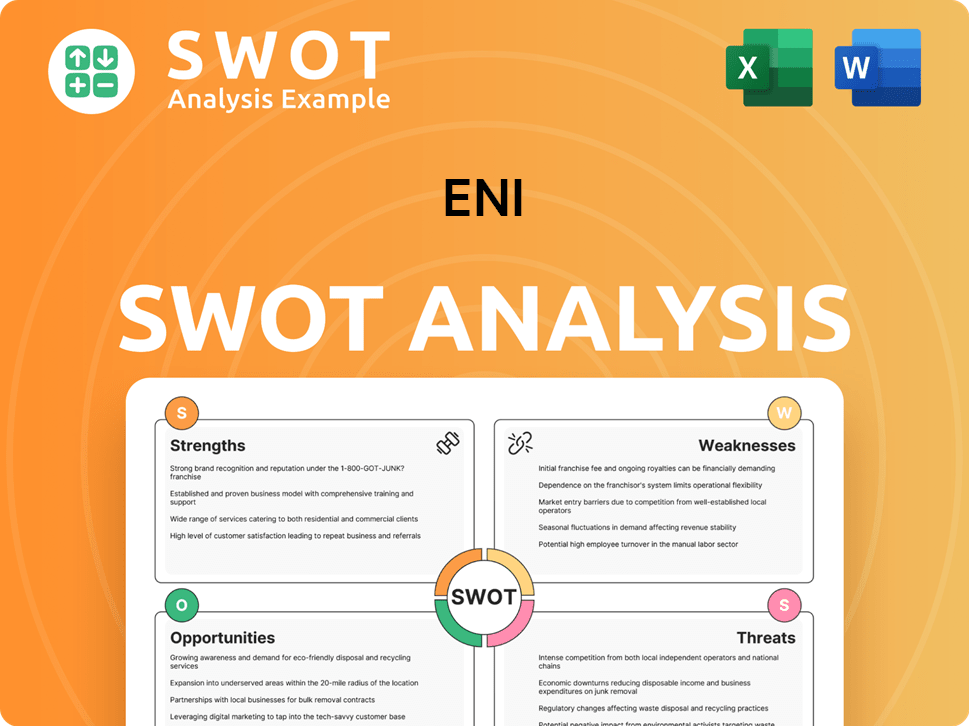
How Has Eni’s Ownership Changed Over Time?
The evolution of the Eni ownership structure reflects a significant shift from its origins as a wholly state-owned entity. The pivotal moment in this transformation was the partial privatization, which commenced in 1995. This involved the initial public offering (IPO) on the Milan Stock Exchange and the New York Stock Exchange, marking a transition from complete state control to a publicly traded company. The initial market capitalization was substantial, reflecting its strategic importance and established operations within the energy sector.
The Italian State remains a major shareholder in Eni. As of April 2025, the Ministry of Economy and Finance (MEF) holds approximately 27.8% of Eni's share capital. Cassa Depositi e Prestiti S.p.A. (CDP), another state-controlled entity, holds around 3.9%. This combined stake of approximately 31.7% ensures the Italian government retains significant influence over the company's strategic direction. The remaining shares are widely held by institutional investors, mutual funds, index funds, and individual shareholders, constituting the company's free float. Major institutional investors often include large asset management firms, pension funds, and sovereign wealth funds from various countries, whose holdings fluctuate based on market conditions and investment strategies. Understanding the Eni ownership structure is key to assessing its strategic direction.
| Key Event | Impact on Ownership | Date |
|---|---|---|
| Initial Public Offering (IPO) | Partial privatization; transition from state-owned to publicly traded | 1995 |
| Subsequent Share Sales | Further reduction of state ownership; increased free float | Ongoing |
| Strategic Partnerships and Investments | Potential changes in shareholder composition; influence on strategic direction | Ongoing |
These changes in Eni's ownership have profoundly impacted the company's strategy and governance. The partial privatization introduced market discipline, pushing Eni towards greater efficiency, profitability, and transparency. The presence of a significant free float means Eni must respond to the demands of a diverse shareholder base, balancing national interests with the pursuit of shareholder value. This has led to a focus on international expansion, diversification into renewables, and a commitment to financial performance. For example, 2024 results show an adjusted net profit of €8.3 billion and adjusted EBIT of €13.8 billion. The proposed dividend is €1.00 per share for 2024. The strategic plan for 2025-2028 emphasizes a balanced approach to energy transition, aiming for sustained cash generation and shareholder returns while pursuing decarbonization targets. Learn more about the Growth Strategy of Eni.
The Italian government, through the MEF and CDP, remains the largest shareholder, ensuring significant influence.
- Partial privatization in 1995 marked a significant shift, introducing market discipline.
- The free float is held by institutional investors, mutual funds, and individual shareholders.
- Eni's financial performance, such as the €8.3 billion adjusted net profit in 2024, is crucial for shareholder value.
- The company balances national interests with shareholder returns, focusing on international expansion and renewables.
Eni PESTLE Analysis
- Covers All 6 PESTLE Categories
- No Research Needed – Save Hours of Work
- Built by Experts, Trusted by Consultants
- Instant Download, Ready to Use
- 100% Editable, Fully Customizable
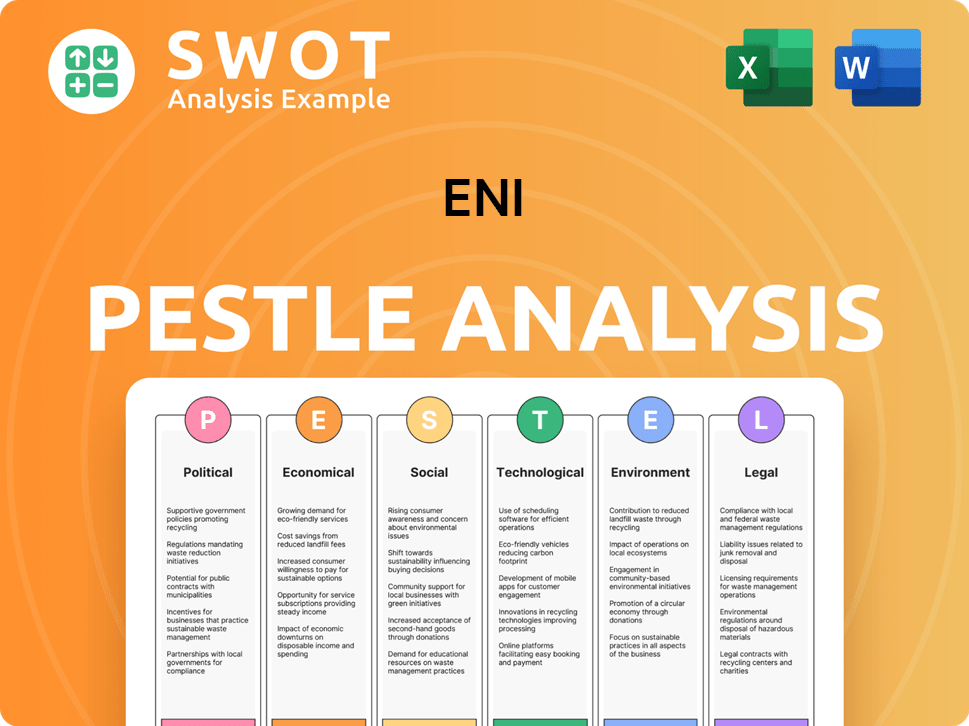
Who Sits on Eni’s Board?
The current Board of Directors of the Eni company is composed of members representing major shareholders, independent directors, and industry experts. Typically, the board consists of nine members, including the Chair and the Chief Executive Officer. The composition ensures a balance between the state's interests and the need for independent oversight. For instance, the Chief Executive Officer is a key executive director, while other directors may be nominated by the Ministry of Economy and Finance, which reflects the state's significant stake in the company. Independent directors are crucial for good governance, ensuring a balanced perspective on strategic decisions and oversight of management. Understanding Eni's marketing strategy gives insights into how the company operates within its governance structure.
The board's structure is designed to facilitate strategic decision-making, aligning with both the state's long-term energy policy objectives and the company's commitment to creating shareholder value. Eni's ownership structure, including the roles of major investors and the Italian government, plays a critical role in shaping the company's strategic direction and operational decisions. The board's composition reflects this balance, ensuring that diverse perspectives are considered in key decisions, from financial performance to sustainability initiatives.
| Board Member Role | Description | Key Responsibilities |
|---|---|---|
| Chair | Leads the board and oversees its functions. | Ensuring effective board meetings, setting the agenda, and facilitating discussions. |
| Chief Executive Officer (CEO) | Key executive director responsible for the company's operations. | Implementing the board's strategies, managing day-to-day operations, and reporting on performance. |
| Independent Directors | Members without significant ties to the company or major shareholders. | Providing independent oversight, ensuring balanced perspectives, and safeguarding shareholder interests. |
Eni operates with a one-share-one-vote voting structure for ordinary shares, ensuring that each share has equal voting power. This standard voting structure ensures that shareholder influence is directly proportional to their ownership stake. The Italian state's continued significant ownership stake provides stability and long-term strategic alignment, often acting as a counterbalance to short-term market pressures. The board's composition and voting structure are designed to facilitate strategic decision-making in line with both the state's long-term energy policy objectives and the company's commitment to creating shareholder value. The company's market capitalization was approximately $44.6 billion as of May 2024.
Eni's ownership structure is a blend of public and private interests, with the Italian government holding a significant stake.
- The board includes members representing major shareholders, independent directors, and industry experts.
- Eni operates with a one-share-one-vote system, ensuring proportional voting power.
- The Italian government's stake provides stability and long-term strategic alignment.
- The board's structure supports strategic decision-making and shareholder value creation.
Eni Business Model Canvas
- Complete 9-Block Business Model Canvas
- Effortlessly Communicate Your Business Strategy
- Investor-Ready BMC Format
- 100% Editable and Customizable
- Clear and Structured Layout
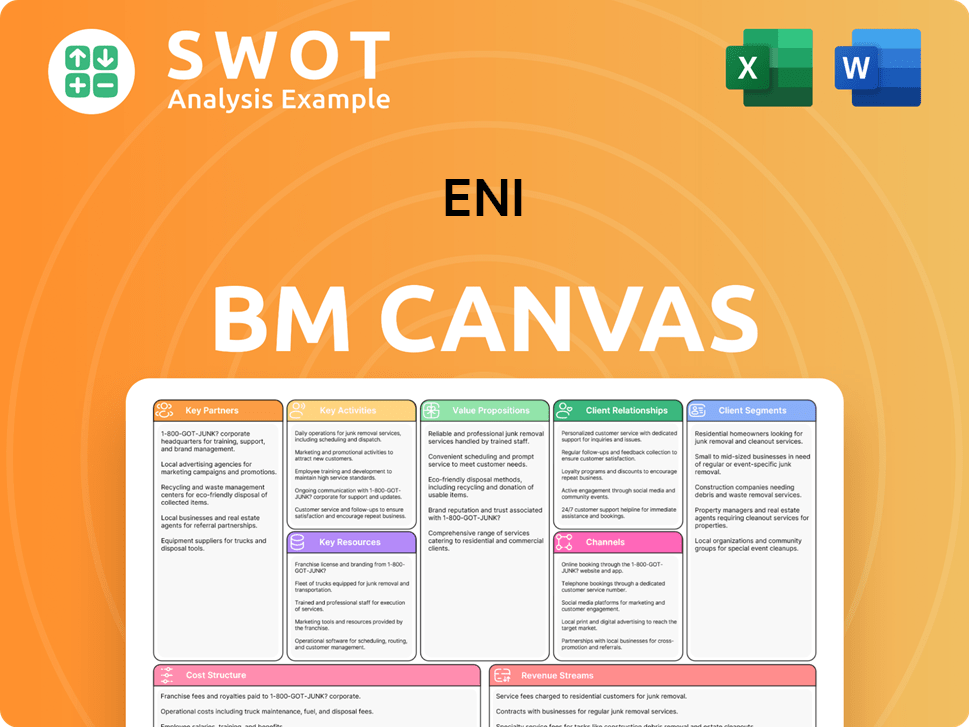
What Recent Changes Have Shaped Eni’s Ownership Landscape?
Over the past few years (2022-2025), the Eni ownership structure has remained relatively stable. The Italian Ministry of Economy and Finance (MEF) and Cassa Depositi e Prestiti (CDP) collectively held approximately 31.7% of Eni's share capital as of April 2025. This significant government stake highlights Eni's strategic importance to Italy's energy security and economic policies. The company's commitment to returning value to shareholders is evident through share buyback programs, such as the one initiated in 2024, with an initial allocation of €1.4 billion.
A key trend influencing Eni is the growing focus on energy transition and decarbonization. This has led to increased investments in renewable energy, biofuels, and carbon capture technologies. Eni's strategic plan for 2025-2028 emphasizes a 'just transition', reflecting its commitment to balancing energy security with decarbonization. The company's hybrid ownership model, balancing state influence with market-driven performance, is expected to continue, with no indications of full privatization or re-nationalization in the near future. The company continues to project strong cash generation and dividend distribution, aiming to attract and retain a diverse investor base. Understanding the Growth Strategy of Eni is essential for investors.
| Ownership Category | Approximate Stake (April 2025) | Notes |
|---|---|---|
| Italian Ministry of Economy and Finance (MEF) & CDP | ~31.7% | Combined state ownership, reflecting strategic importance. |
| Institutional Investors | Variable | Influenced by Eni's sustainability targets and energy transition investments. |
| Retail Investors | Variable | Attracted by dividend distributions and market performance. |
Eni's commitment to its current ownership model is further reinforced by its financial strategies. The company continues to focus on generating strong cash flow and distributing dividends, which are key factors for attracting and retaining a diverse investor base. The absence of major shifts in leadership or significant mergers or acquisitions that would alter the core Eni company owner structure underscores the stability of its current approach. Public statements from the company and analysts consistently support this commitment, ensuring that Eni shareholders can expect a balanced approach to state influence and market-driven performance.
The Italian government, through the Ministry of Economy and Finance (MEF) and Cassa Depositi e Prestiti (CDP), holds a significant stake.
A hybrid model with state influence and market-driven performance, aiming for a balance between energy security and shareholder value.
Emphasis on energy transition, decarbonization, and investments in renewable energy sources.
Strong cash generation, dividend distributions, and a commitment to shareholder value are key strategies.
Eni Porter's Five Forces Analysis
- Covers All 5 Competitive Forces in Detail
- Structured for Consultants, Students, and Founders
- 100% Editable in Microsoft Word & Excel
- Instant Digital Download – Use Immediately
- Compatible with Mac & PC – Fully Unlocked
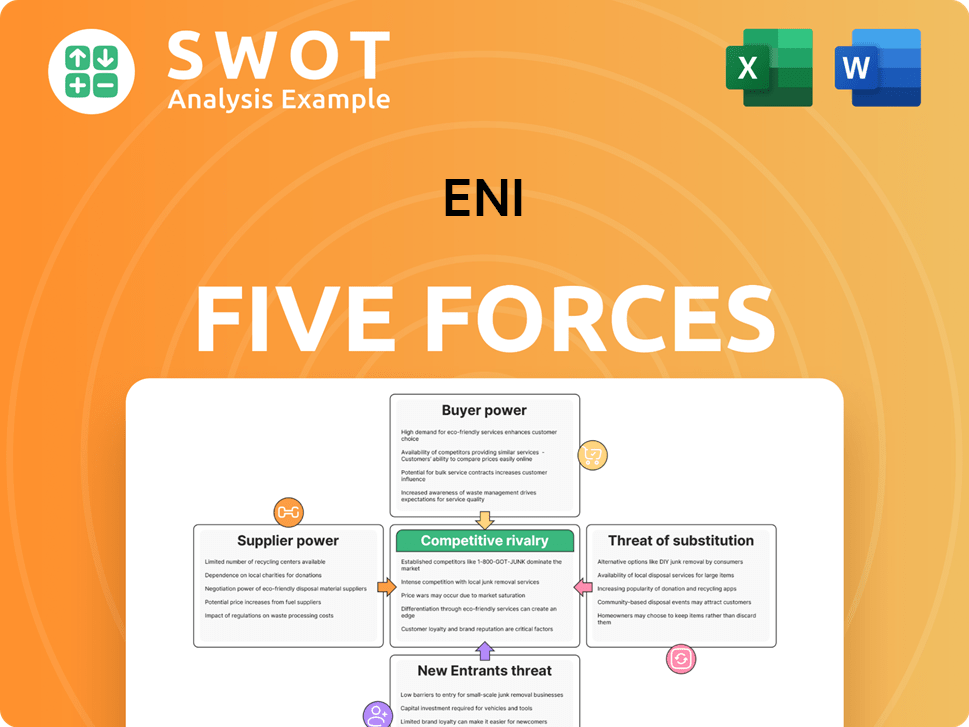
Related Blogs
- What are Mission Vision & Core Values of Eni Company?
- What is Competitive Landscape of Eni Company?
- What is Growth Strategy and Future Prospects of Eni Company?
- How Does Eni Company Work?
- What is Sales and Marketing Strategy of Eni Company?
- What is Brief History of Eni Company?
- What is Customer Demographics and Target Market of Eni Company?
Disclaimer
All information, articles, and product details provided on this website are for general informational and educational purposes only. We do not claim any ownership over, nor do we intend to infringe upon, any trademarks, copyrights, logos, brand names, or other intellectual property mentioned or depicted on this site. Such intellectual property remains the property of its respective owners, and any references here are made solely for identification or informational purposes, without implying any affiliation, endorsement, or partnership.
We make no representations or warranties, express or implied, regarding the accuracy, completeness, or suitability of any content or products presented. Nothing on this website should be construed as legal, tax, investment, financial, medical, or other professional advice. In addition, no part of this site—including articles or product references—constitutes a solicitation, recommendation, endorsement, advertisement, or offer to buy or sell any securities, franchises, or other financial instruments, particularly in jurisdictions where such activity would be unlawful.
All content is of a general nature and may not address the specific circumstances of any individual or entity. It is not a substitute for professional advice or services. Any actions you take based on the information provided here are strictly at your own risk. You accept full responsibility for any decisions or outcomes arising from your use of this website and agree to release us from any liability in connection with your use of, or reliance upon, the content or products found herein.